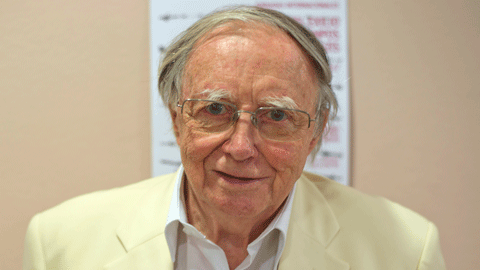"Most survivors speak very highly of the Spaniards of Mauthausen"

15/06/2017
David Wingeate Pike, emeritus professor of contemporary history and politics at the American University of Paris, gave a conference entitled "A Testimonial to the Nobility of the Spaniards of Mauthausen" at the seminar on writings during the Republican exile in Nazi concentration camps, organised on 7 and 8 June by the Study Group on Literary Exile (GEXEL-CEFID) of the UAB and the Barcelona City Council. Dr Pike, a renowned expert of the Spanish community at the Mauthausen concentration camp, is author of one of the most important books on the subject Spaniards in the Holocaust (Routledge). In his book, he narrates the horrible experience of fighting for survival of seven thousand Spanish prisoners, many of them veterans of the Spanish Civil War who previously had also suffered in the internment camps of France. The Spaniards who survived Mauthausen later provided valuable information on the reality of living in a Nazi concentration camp.
Why were Spaniards mostly deported to Mauthausen?
The Nazis considered that they deserved the worst treatment. They were the first enemies of the Reich, anti-Fascists since 1936, and they wanted to punish them by sending them to the worst of camps. There were three classes of camps and Mauthausen was the most severe and the only one which was permanently classified by the SS as Stufe drei, category 3.
There seemed to be many Catalans among the 7,000 prisoners, do we know how many exactly?
Spanish historians have calculated the numbers, but I do not think they are completely accurate since the German reports did not specify what part of Spain they came from. They were all identified with the letter S.
Among them were veterans from the Republican army and Communist partisans.
Almost all were veterans of the Spanish Civil War and veterans of prison life in France. These two experiences hardened them for this ultimate ordeal; the Nazis had nothing worse to offer than this, where death was programmed, but not instant. Mauthausen was not a Vernichtungslager, an extermination camp, it was an Ausmerzungslager, and this meant death by extenuation, slow death by famine, exhaustion, by ill treatment. With regard to ideology, it is worth highlighting that Communists, Anarchists and bourgeois Republicans put aside their differences, since they were mortal enemies in 1937. They had to forget their ideologies in a situation like this, the important thing was to find ways to survive. That means burying the past and working together. That was not peculiar to the Spanish however.
What makes the Spaniards different from other prisoners at Mauthausen?
The vast majority of those who knew the Spaniards in Mauthausen speak so highly of their behaviour. There are only two critical references to their conduct. They are included in my book, but I dismiss them as being made out of resentment; and the fact that they are anti-Semitic as well as anti-Spanish, in my opinion disqualifies them from being objective accounts. There were some cases, such as the famous Commander César [name given to Moisés Fernández Pascual], a Spanish who was made Kapo [prisoner who was given privileges in return for supervising other prisoners] and who was hated in general, even by his fellow Spaniards.
Did the presence of veterans from the Republican army help the Spanish to organise a resistance within the Lager?
Yes, the resistance however was never as large or as important as some survivors aim to make us believe, simply because of the enormous difficulties they were facing.
You spoke in your conference about a Spanish Kapo and said there were others who had administrative responsibilities.
Some were made Prominenter [prisoners chosen to occupy a specialised position]. When Juan de Diego entered as a Lagerschreiber, an administrator, at the administration office, Schreiberstube, he was able to steer Spaniards into the position of Prominenter. That made all the difference between life and death. When the Spanish arrived, they had no title to any of the posts which would give a prisoner a chance for survival. Once Juan de Diego was in, he had the opportunity to rearrange things, but at the beginning, the Spaniards had nothing.
Can you tell me about the documentary value of the photos preserved Antonio García and Francesc Boix?
They are the some of the clearest evidence of Nazi crimes. There is a polemic about who saved the photos. Antonio García was working at the photographic service since 1941 and Francesc Boix arrived later, as a result of Antonio's recommendation to Paul Ricken, the SS in charge of the photo service. García saved two hundred prints and Boix saved two thousand negatives. Antonio entrusted Boix with his 200 prints right before he went into the prisoner's hospital. When he later came out, he discovered the prints had disappeared. In other words, Boix had moved them from the photo service compound into various hiding places. Antonio was obviously furious at what he felt was betrayal and remained resentful all his life.
Did they ever make amends?
Antonio never forgave Boix. I met him 15 years before he died, and we maintained a long friendship. He never forgave Boix. He formulated a wrong judgement of Boix that I at first adopted, since I had no reason to suppose he was not giving a straight account. In the end it wasn't a straight account and I have corrected this error in the newer editions of my book. In this new fifth edition, I think I got the right formula and have reached the right conclusion: Antonio saved his photographs, Boix saved his; Boix then stole Antonio's, but then saved the lot. And the rest is simply a matter of numbers, who saved what. But we will never know because the photographs have been mixed ever since 1945.
More information:
Study Group on Literary Exile (GEXEL)